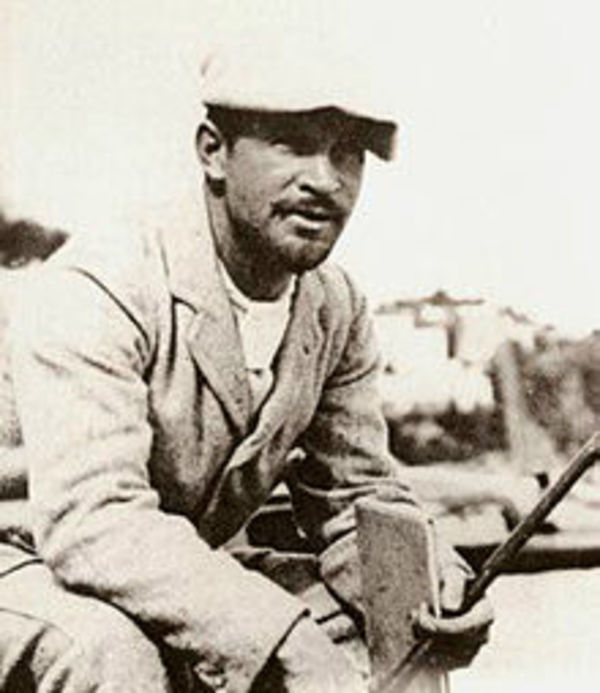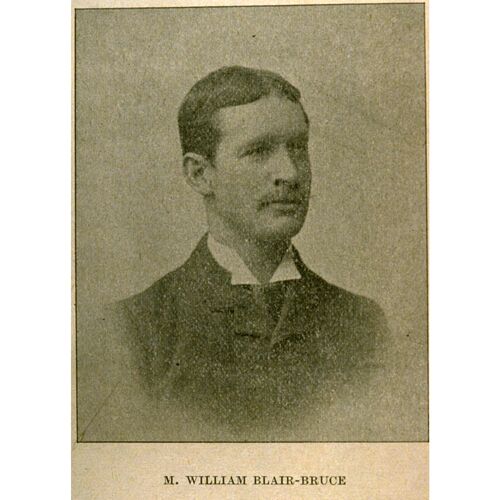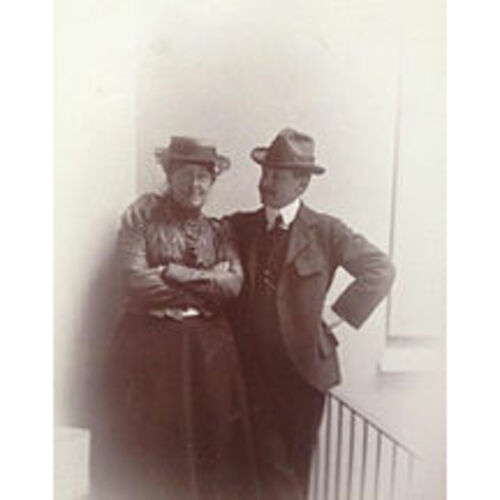
Source: Courtesy of Wikimedia Commons
BRUCE, WILLIAM BLAIR, painter; b. 8 Oct. 1859 in Hamilton, Upper Canada, son of William Bruce and Janet Blair; m. 4 Dec. 1888 Carolina Benedicks in Stockholm; they had no children; d. there 17 Nov. 1906.
As a youth, William Blair Bruce studied law at the Hamilton Collegiate Institute before working for three years in a handwriting academy run by his father, a gifted calligrapher and amateur water-colourist. Both parents encouraged his artistic talents. He took painting lessons from his father, from John Herbert Caddy*, and from Henry Martin, and briefly attended the Hamilton Art School in 1877. After three years of study in an architect’s office he settled on a career: to become an artist. In May 1881 he showed two oils and a water-colour with the Ontario Society of Artists [see John Arthur Fraser*].
Like many Canadian artists of his generation, such as Paul Peel* and George Agnew Reid*, Bruce planned to further his career by training and exhibiting in Paris. With the blessing and financial support of his mother, grandmother, and aunt, he soon sailed for Liverpool, England. A letter from Paris dated 10 July 1881 marks the first of some 120 letters he sent home. An invaluable chronicle of a Canadian artist abroad, the correspondence documents the sometimes terrible struggle to survive and succeed.
By October Bruce had entered the Académie Julian, where he studied under Adolphe-William Bouguereau and Tony Robert-Fleury, respected painters in the then-prevalent academic style. They instilled in Bruce a belief in the primacy of the human figure – carefully observed and then, through an arduous process of drawing and oil sketching, incorporated into large paintings suitable for inclusion in the annual Paris Salon. At the same time, however, Bruce was committed to painting landscape views en plein air, pictures saturated with, in his words, “the feeling of things, the spiritual more than the earthly.” His Une lisière de la forêt – matin (current location unknown) was accepted in the 1882 Salon, a mark of favour for one so recently arrived.
The next two years Bruce spent primarily in Barbizon, a small village and artists’ community near Paris, labouring intensely towards a single goal – the creation of a major painting full of “the greatest Sentiment” which would gain him a Salon prize and secure his career. He almost foundered under the burden of work and the costs of paint, canvas, models, picture frame, and studio. Yet his large and ambitious oil painting Temps passé (Owens Art Gallery, Sackville, N.B.), with its touching contrast of old age and youth clearly conceived to attract attention, was exhibited in the 1884 Salon, and indeed was well displayed and favourably reviewed. But no prize was forthcoming.
Bruce’s great effort had taken its toll. He carried on for a year before succumbing to a breakdown (“I sometimes think my brains are shattered”). In the fall of 1885 he sailed home to recuperate, only to suffer another set-back, perhaps of greater magnitude: the ship transporting approximately two hundred of his works for exhibition in Toronto, Hamilton, and London sank off Île d’Anticosti on 8 November and all were lost.
Bruce remained a year in Hamilton before returning to Paris in late 1886. After spending a few months in Barbizon he settled in Giverny with several American artist friends. Theodore Robinson, a close associate of Claude Monet, who lived nearby, in particular was to have considerable impact on the Canadian’s developing style. Bruce’s large, carefully worked-out figural pieces of the early and mid 1880s were rapidly replaced by small, brilliantly coloured and vividly brushed landscapes in a pure impressionist mode. (He was eventually to return to the production of vast Salon “machines” in the 1890s, the equivalent of leaping from one of the most advanced styles of the day back to the conservatism of his earlier style.) Landscape with red flowers (1887, Art Gallery of Ontario, Toronto) pulsates and dazzles – a Canadian masterpiece in this style and irrefutable evidence of Bruce’s outstanding talent.
On 4 Dec. 1888 in the British embassy at Stockholm Bruce married a wealthy and socially prominent Swedish sculptor, Carolina Benedicks; a sacerdotal ceremony was held the following day in the cathedral. Over the next two decades they travelled and worked – visiting Paris, Capri, Italy, Hamilton (in 1895, when he painted on the Six Nations Reserve), and, increasingly, Stockholm and the Swedish island of Gotland. There, around 1900, near Visby, Bruce and his wife completed a large house, Brucebo, which was to serve as their primary residence.
The remarkable promise demonstrated by Bruce, particularly in Giverny, was never to be fully realized. A career which might easily have produced the most important body of paintings by a Canadian in the impressionist manner became fractured. Despite a considerable output and many fine paintings from his later years – especially portraits of his wife and twilight views of Stockholm and the sea – his reputation has suffered from the wide variety of his subjects (portraits, landscapes, genre, mythology, and the nude) and, more significantly, the eclecticism of his style (vacillating between impressionism and the academism of his early career with overtones of James Abbott McNeill Whistler, the Barbizon School, and Scandinavian romanticism). Yet in his day Bruce enjoyed widespread recognition in Europe as well as an exhibition record that included, in Paris, the prestigious Salon 15 times between 1882 and 1906 and the universal exposition of 1900 (at which, in his words, “it appears” he was awarded a medal); the Royal Academy of Arts in London; the Royal Canadian Academy of Arts in Toronto; an exhibition of over 130 works in Stockholm in 1897; the Pan-American Exposition of 1901 in Buffalo, N.Y., where he won a gold medal; and a posthumous retrospective of 122 works held in Paris in 1907.
A gift of 29 paintings to the city of Hamilton by his widow led to the founding of what is now the Art Gallery of Hamilton. The largest selection of his works outside Brucebo is currently housed there. A scholarship provided by Carolina sponsors the studies of a Canadian art student each summer at Brucebo.
A selection of William Blair Bruce’s correspondence with his family has been published as Letters home, 1859–1906: the letters of William Blair Bruce, ed. and intro. Joan Murray (Moonbeam, Ont., 1982). The originals are housed in the Bruce papers at the Art Gallery of Hamilton, Ont., which holds the bulk of the primary source material on the artist. A few important items are located at the HPL. In addition to the museums named in the text, Canadian public collections with works by Bruce include the National Gallery of Canada (Ottawa), the Confederation Centre Art Gallery and Museum (Charlottetown), and the Robert McLaughlin Gallery (Oshawa, Ont.).
Art Gallery of Ontario, Library (Toronto), W. B. Bruce artist file (microfiche), “Short sketch of W. Blair Bruce, artist, Paris” (typescript, [c. 1901]). Hamilton Spectator, 16 Nov. 1935. Sylvain Allaire, “Les Canadiens au Salon officiel de Paris entre 1870 et 1910: sections peinture et dessin,” Journal of Canadian Art Hist. (Montreal), 4 (1977–78): 141–54. DHB. Exposition rétrospective de l’œuvre de W. Blair Bruce; ouverte du 11 au 26 mai 1907 (catalogue d’exposition, Georges Petit Galeries, Paris, 1907). Harper, Early painters and engravers. Joan Murray, William Blair Bruce (exhibition catalogue, Robert McLaughlin Gallery, 1975). Saturday Night, 26 Feb. 1927. Robert Stacey, “A contact in context: the influence of Scandinavian landscape painting on Canadian artists before and after 1913,” Northward Journal (Moonbeam), no.18/19 (1980): 36–56. Standard dict. of Canadian biog. (Roberts and Tunnell). David Wistow, Canadians in Paris, 1867–1914 ([Toronto], 1979).
Cite This Article
David Wistow, “BRUCE, WILLIAM BLAIR,” in Dictionary of Canadian Biography, vol. 13, University of Toronto/Université Laval, 2003–, accessed April 26, 2025, https://www.biographi.ca/en/bio/bruce_william_blair_13E.html.
The citation above shows the format for footnotes and endnotes according to the Chicago manual of style (16th edition). Information to be used in other citation formats:
| Permalink: | https://www.biographi.ca/en/bio/bruce_william_blair_13E.html |
| Author of Article: | David Wistow |
| Title of Article: | BRUCE, WILLIAM BLAIR |
| Publication Name: | Dictionary of Canadian Biography, vol. 13 |
| Publisher: | University of Toronto/Université Laval |
| Year of revision: | 1994 |
| Access Date: | April 26, 2025 |






